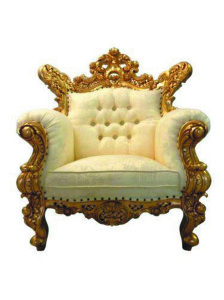If you’ve always yearned to live like a king, gold trimmed furniture reproductions await you. They may look like rare antique Baroque and Rococo chairs and beds, but they are made in quantity these days and usually priced in the thousands of dollars.
Often they turn up mislabeled at antique shows, shops and auctions. One is even labeled “a throne chair.” When I recently started researching Baroque and Rococo reproduction furniture on the internet, I was amazed at the popularity of reproductions, brand new and made in the early 20th century. La Maison Of London is known for its hand carved reproductions.
And, there are others.
Even when properly labeled at reputable auctions Baroque pieces can be costly, depending on the craftsmanship. Victorian Rococo, however, is totally out-of-favor and sells in the low hundreds, if at all. Historically, 17th century Baroque furniture used heavy, dimensional carving of figures and floral motifs. Gilding and lacquer were lavishly applied and made for European royalty. It became an international style, along with the discovery of new furniture making techniques such as veneering, and the importing of fabrics from many countries. Rich damasks were used for draperies and cut velvet for seating pieces.
The era of Louis XV (1723-1774) marked the beginning of Rococo interior decoration. The carving of the Baroque age was still in evidence but not as heavy. The cabriole leg was introduced to furniture and heavily upholstered pieces. Many new types of furniture for a specific purpose emerged. Among them the chaise longue and small tables, decorated with painted scenes and covered with gilt.
German Rococo furniture of the period was influenced by France, but the pieces were heavy and often combined black lacquer and gilt trim.
CLUES: That heavily carved and gilded armchair that the family has regarded as a valuable family heirloom, may actually have been one of the many made by Sears Roebuck from the late 19th to early 20th century. Around the 1900s there was another revival of Baroque and Rocco styles. These reproductions were well-carved, but not made with the tools of the earlier eras. Instead they can be recognized as reproductions by the circular saw marks.
You’ll need plenty of gold to pay for gilded pieces.
Pictured: a reproduction armchair from elire-0777-59-33333. UK
















Follow Us